Contents
- Rules for planting and caring for plums in the open field
- Features of the plum root system
- How to plant a plum
- Selecting the right variety
- When to Plant a Plum: Spring or Fall
- Where is it better to plant a plum on the site
- Next to what you can plant a plum
- Is it possible to plant a plum alone
- Good Neighbors for a Plum
- Is it possible to plant a plum next to a cherry
- How plums and cherries grow side by side
- Neighborhood of plum and currant
- Is it possible to plant a plum next to an apple tree
- Neighborhood plums and raspberries
- At what distance to plant a plum from a pear
- Neighborhood of plum and peach
- Plum and honeysuckle compatibility
- Is it possible to plant different varieties of plums next to each other
- What can be planted under a plum
- Cannot be planted next to a plum
- How to choose a plum seedling
- What kind of soil does a plum like?
- What fertilizers are applied when planting plums
- How to plant a plum in spring: step by step instructions
- The nuances of planting plums in the fall
- Planting a plum with a closed root system in spring
- Do I need to prune a plum seedling when planting
- How to feed a plum after planting
- Watering plum seedlings after planting
- How to transplant a plum
- Cultivation and care of plum
- Mistakes beginner gardeners make
- Conclusion
Planting plums in the spring is not difficult even for beginner gardeners. The presented material is an intelligible and detailed guide, including simple techniques for planting and growing a plant, as well as caring for it. The collected advice from experienced gardeners will make it easy to understand agricultural technology, variety selection and an undesirable neighborhood for plums.
Rules for planting and caring for plums in the open field
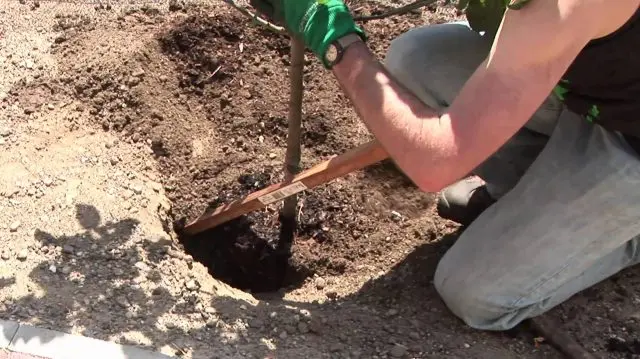
To get high yields, you must follow the rules for planting and growing plums. Growing a tree is not easy, it requires desire, patience and hard work.
Need to know:
- What are the dates for planting?
- how to prepare the soil to please the plum;
- what size should the landing pit be;
- why it is important not to deepen the root neck;
- how to properly grow and care.
Features of the plum root system
The plum root system has its own characteristics, which must be taken into account when planting, growing and subsequent care.
- It consists of skeletal (up to 5–8 cm) and overgrowing (up to 0,3 cm thick) roots.
- Their main mass lies horizontally in the ground at a depth of 20–40 cm. Only individual roots penetrate 60–80 cm. Closer to the root collar, they reach the surface of the earth.
- Skeletal roots provide the stability of the plum, its strong connection with the ground. Often the root system extends beyond the projection of the crown.
- Overgrown roots provide absorption of mineral solutions from the soil. The growth of shoots, leaves and fruits depends on how developed this part is.
- Timely care contributes to the good development of the root system: watering, the correct fertilizing schedule, loosening the topsoil.
- Plum forms a large number of root offspring. This is one of the ways to grow a variety.
What is the root system of a plum
To successfully grow a crop and care for it, you must have at least some knowledge of botany.
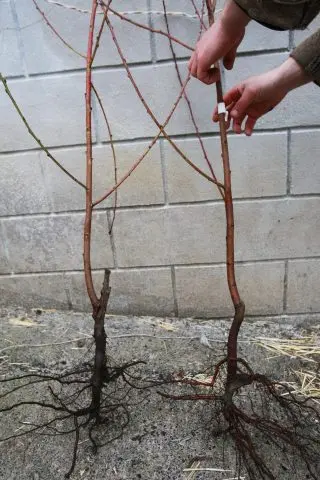
From the school course, everyone knows about the existence of two types of roots: taproot and fibrous, but in fact the underground part of the tree is much more complicated. Despite belonging to one of these species, their shape and direction of distribution can be completely different. All trees have taproots, plums are no exception. But, not only the main part is developed in her, but also the lateral, expressed more than the rod.
How plum roots grow
For planting and growing plums, it is important for a gardener to know how the root part of the plant is located underground (both vertical and horizon).
The underground part occupies the surface horizon of the soil layer at a depth of 15 to 60 cm. A small number of roots grow vertically and reach a depth of 1,5–2 m. If the tree grows in arid steppe regions, they sometimes penetrate to a depth of 4,5 m.
The horizontal roots of adult 30-year-old plums can be located at a distance of 10 meters from the trunk. Their length is 2 or even 3 times the radius of the crown.
The depth of the roots of cherries and plums
The root system of the sweet cherry penetrates to a depth of 40–60 cm, at the plum this figure is 60–80 cm. In the garden they do not favor each other, they are adjacent at a distance of 5 m. the roots are located at a distance of 15 to 30 cm. The structure of the roots of these plants is identical. The indicator of the required depth of groundwater is also almost the same – 15–40 meters.
How to plant a plum
Many summer residents are afraid to root a seedling in the fall, fearing that it will not have time to take root and freeze. This will not happen if you properly prepare the soil, choose a variety and apply fertilizer when planting plums.
Selecting the right variety
The success of the future harvest largely determines the compliance of the plum variety with the climatic conditions of growth. It is worth giving preference to zoned varieties intended for cultivation in a particular region.
When choosing a tree for planting, the following characteristics are taken into account:
- maturation period;
- resistance to low temperatures;
- fruiting level;
- susceptibility to major diseases.
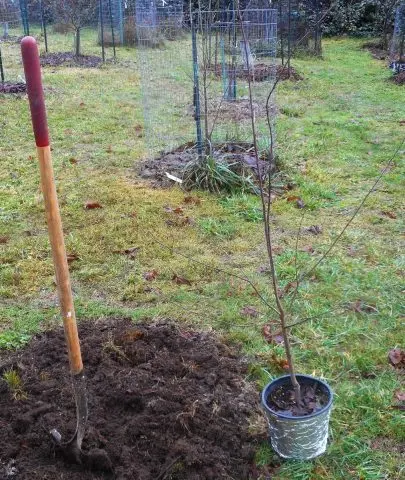
When growing one variety, only self-fertile plum varieties give a high yield. For the rest, pollinating varieties are needed, for example, Red early ripening. Plums of central Our Country are distinguished by large sweet fruits, good yields and resistance to frost.
Varieties of plums for the central regions of Our Country:
common hungarian
| Productivity – up to 30 kg, a very beautiful crown in the form of a leaf. The variety is not only winter-hardy, but also tolerates drought well. Ripens at the end of August. The weight of one fruit is 40 g, the taste is sweet and sour.
|
Morning
| The variety is sensitive to cold, but recovers quickly. Fruiting – 4 years after planting. Productivity – 15 kg per tree. The fruits are fragrant, medium sweet. Self fertile variety.
|
Zarechnaya early
| The tree is compact in shape, begins to bear fruit in the fourth year. The variety is frost and disease resistant. Large-fruited, weighs from 30 to 60 g, tasty. Reaches maturity by mid-July. One of the best varieties of plums for planting and growing in the Moscow region. The variety is self-infertile.
|
Egg blue
| The variety is frost-resistant. Ripens at the end of August, begins to bear fruit in the 5th year. Fruits are ovoid, small. The pulp is juicy, amber in color, very sweet. Self fertile. After planting, it does not require complex care.
|
When to Plant a Plum: Spring or Fall
It happens that during the autumn planting, the plum does not have time to take root and later dies. In winter, it is difficult to follow the further development of the plant and eliminate the problems that have arisen. When choosing a particular season for planting plums, they are guided by the peculiarities of the climate of the region.
Plum planting dates in spring
Experienced gardeners recommend planting plums in open ground in spring, in April or early May. Although the threat of frost has not yet passed, the earth has warmed up, and the root system will take root well. Such a plum will overwinter without any complications for it. It is important at this time to provide the drain with protection from the cold wind. It is necessary to plant a plant in a hole dug before winter and prepared, fertilized soil. This will facilitate the cultivation and subsequent care.
Planting dates for plums in the fall
If plum planting is planned for autumn, the best period for this is from September 20 to October 20 (deadline), a month before the onset of cold weather. At this time, the underground part of the plum is strong, it is not afraid of damage, but it may not endure severe winter frosts. Therefore, the plum from winter frosts for the winter should be covered (it is good to mulch, cover with spruce branches).
Landing in the southern regions is good to carry out in the second decade of October. The plum will have time to settle in the ground before the cold weather, the soil will securely clasp the roots, and moisture will remove all the voids. Winter in the south is warm, more like autumn, so the seedling will overwinter without hassle, and most importantly, it will have time to adapt to the onset of hot weather.
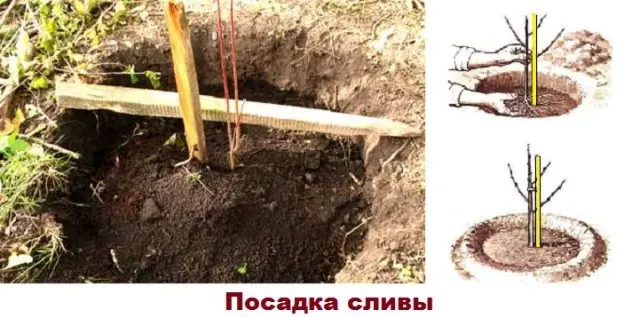
In the northern territories, planting in autumn is risky and difficult. The plum will need additional care: it will be necessary to rake snow to it, whiten the trunks so that the bark does not crack. You can tie them with special material or paper, but it’s expensive. Even if the trees have overwintered, they can be destroyed by spring floods. Therefore, the best time for planting seedlings in the north is spring. Growing and caring in this case will not cause unnecessary trouble.
Is it possible to plant a plum in the summer
Summer heat for trees with a superficial root system is detrimental. Planting plums in late spring and summer is highly undesirable. If there are still reasons to do this, one must be prepared for the fact that there will be no harvest this year, and subsequent cultivation and care will be difficult.
Where is it better to plant a plum on the site
When planting a plum, you need to fulfill the required conditions: choose the right place for planting and take into account its biological characteristics.
- Plum cultivation should be done in places where there are no cold eastern and northern winds, on gentle slopes.
- You can not shade it with tall trees and outbuildings.
- The main underground part of the plum is superficial, so it is important that the groundwater does not come close to the top layer of the earth where it grows.
- Do not plant a plum in a lowland area where a lot of water and snow accumulate.
- Plum soil likes fertile, light and neutral (pH 5,5-6). If the soil is acidic, it must be neutralized with dolomite flour or lime (every 4 years).
- Pollinating varieties during cultivation are located at a distance of 3 meters from the planted plum.
Can a plum grow in partial shade
If the plum falls into the penumbra of a tree or fence for a short daylight time, this is not bad. In summer, the temperature sometimes reaches record levels, and the sun’s fire can burn not only the leaves, but also the trunk of the plum tree. Then such protection is a real salvation for the plum. In winter, such care shelters from the icy wind.
At what distance to plant a plum from the fence
The root system of the plum can eventually begin to destroy nearby buildings, sometimes, unfortunately, strangers. Neighbors complain that the shadow from a plum planted close to the fence obscures their plantings, and the plum itself fills the area with leaves and fruits. For this, there are sanitary norms and rules (SNiP) for the optimal planting of trees and shrubs. The instruction clearly defines the distance from the fence to a shrub or a low tree (SNiP 30-02-97) of two meters, tall – 3 m. This is important both from the point of view of fire safety, and for growing and care.
Next to what you can plant a plum
The ecosystem of garden plots is usually represented by a rich variety of fruit tree varieties. To obtain stable yields, it is important that it is in balance, and to maintain it, it is necessary to know the characteristics of each plant species. Many trees emit inhibitors – substances that depress nearby crops, some can even transmit diseases. It is in the power of everyone to create a garden in which the trees will be good neighbors, acting favorably on each other.
Is it possible to plant a plum alone
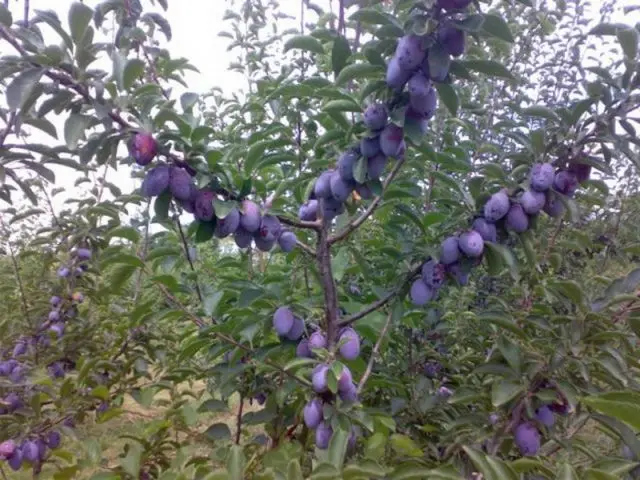
Some plum varieties are self-fertile, but even for these, a pollinator is desirable.
If it is not possible to grow another plum nearby, it is recommended to graft the desired pollinator variety into the crown.
Good Neighbors for a Plum
- The apple tree gets along well with the plum. There are opposing opinions on this matter, but it is not uncommon to see a plum and an apple tree growing nearby and hear the stories of experienced gardeners about the rich harvests obtained from such a neighborhood.
- Black elderberry saves plum from aphids.
- If space permits, then to increase the yield of plums, it is worth planting a maple nearby, however, he will have to regularly trim the crown.
Is it possible to plant a plum next to a cherry
Plum and cherry get along well together and protect each other from diseases. They can be planted close, but so that the crowns do not touch.
How plums and cherries grow side by side
It is not recommended to grow plums between cherries and cherries. She is “friends” with cherries, but not so much with cherries. Their rhizomes lie in the same horizon, and if the sweet cherry is more powerful, it will displace the underground part of the plum from the humus into the infertile lower layers. This will lead to a significant weakening of the plum. Plant them at a distance of 5 meters from each other.
Neighborhood of plum and currant
Blackcurrant, like plum, does not like any neighborhood. The currant will not fight for a place under the sun, as it feels good in the shade, but the underground part grows strongly and comes into conflict with the root system of the plum. They will oppress each other, so cultivation and care will be difficult.
The situation is better with planting a number of red currants – non-aggressive and accommodating. Its rhizomes are located at an average depth, so there will be no strong competition for nutrients.
Is it possible to plant a plum next to an apple tree
The apple tree is a versatile plant and gets along with almost all trees in the garden, including plums.
Neighborhood plums and raspberries
Both plums and raspberries have shallow root systems, and there is a constant war between them for nutrient solutions. In terms of the speed of spreading through the garden, raspberries are a real aggressor, they can grow and eat everywhere and do great harm to the plum, intertwining with its roots and impoverishing the soil under it.
At what distance to plant a plum from a pear
The pear has a strong root system, a powerful, up to 5 meters wide crown, it reaches a height of 15 m. The pear is perhaps the most photophilous of all fruit trees. Such power next to the plum will not last long. In the struggle for the sun, it will fail, but thanks to the surface horizon of the roots, it will suck out all the nutrients from the humus. And plum has the ability to provoke diseases to which pears are prone. Planting these crops should be away from each other, at a distance of 6 meters.
Neighborhood of plum and peach
The peach is a solitary tree, it cannot stand any neighbors. This culture is delicate, requiring care. Next to the plum, she is uncomfortable, since both plants are susceptible to many diseases.
Plum and honeysuckle compatibility
Honeysuckle grows well next to plums. A small shrub feels comfortable and is not afraid of light plum shade. Cultivation is possible at a distance of 2 meters from each other.
Is it possible to plant different varieties of plums next to each other
Many varieties of plums are self-fertile, which means that for pollination and getting a good harvest, you will need one more, or rather several simultaneously flowering varieties of this crop.
What can be planted under a plum
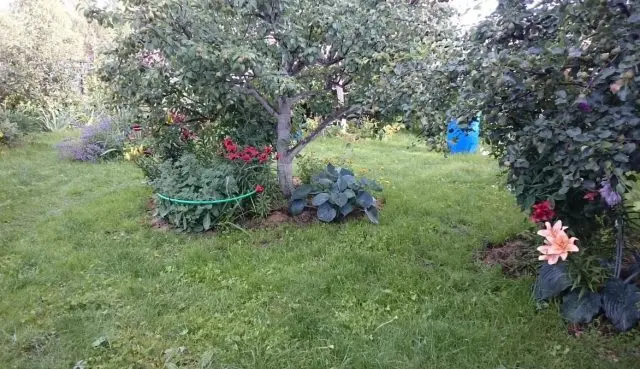
The trunk circle of the plum can be covered with lawn turf. Suitable bent grass, white clover, bluegrass meadow or fescue. Under the plum, the cultivation of bulbous, primrose, and celandine is favorable.
Cannot be planted next to a plum
Not all representatives of the plum flora are good.
- He does not like plum pear, raspberry, black currant, does not get along well with plantings of sea buckthorn and cherries.
- Cultivation next to a birch (even decorative) is contraindicated. She will suck out all the water from the ground, and the plum will die.
- The plum of the neighborhood with walnut plantings will not endure. This is a natural herbicide containing juglone, which, having fallen from the leaves into the ground, will destroy all vegetation under its crown.
- They do not allow growing near the plum of anemone – a weed on which a rust fungus develops. This mushroom has many houses and the next one could be a plum.
How to choose a plum seedling
In order for the seedling to take root well and turn into a productive plum, and caring for it was not problematic, you need to take care of the quality of the planted material before planting.
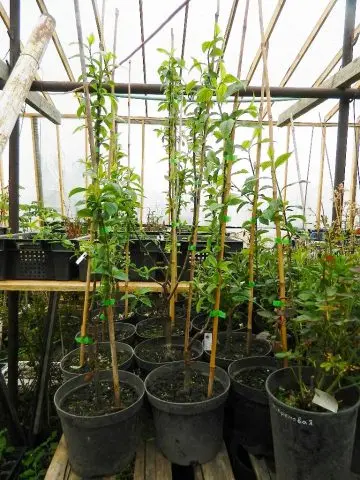
First of all, it is recommended to carefully examine the tree. You should not buy if:
- damaged or broken shoots;
- they are connected by wire and smeared with mud;
- trunk damaged by hail;
- dried or rotted seedling, with moldy areas;
- bulges were found on the rhizome or brown spots, similar to foci of black cancer;
- the grafting site is bent and crooked;
- brown roots, drooping, dying;
- close to the ground there are useless branches;
- the trunk has defects and bifurcation.
One-year-old or two-year-old seedlings are suitable for planting (they take root better).
When buying, be sure to inspect the root system. It should be of normal color and have a branched structure. They look at the aerial part: the better it is developed, the more roots there should be. An annual plant should have 3–4 skeletal roots of 25–30 cm each and side shoots.
You also need to inspect the place of vaccination:
- whether it is completely covered by the bark;
- whether it is located very low (normally – 10 cm).
Only if these rules are followed, planting and growing plums will be successful, and care will be easy and enjoyable.
What kind of soil does a plum like?
Plum is a moisture-loving tree. Its bark and wood do not retain water well, the roots are located in shallow, surface horizons, where the water regime is unstable, so cultivation should take place in low areas where it is possible to maintain normal humidity with the help of irrigation. You can not allow waterlogging. The groundwater level should be no higher than two meters from the surface of the earth.
What fertilizers are applied when planting plums
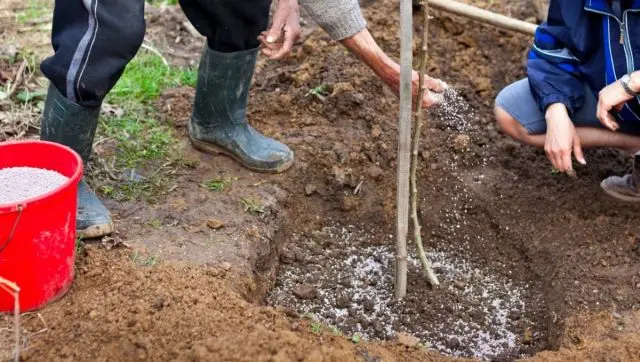
Each gardener can improve the composition of the soil in which he will grow plums. The landing site is dug up on a full bayonet of a shovel with the simultaneous introduction of organic matter and minerals into it. They do this in mid-autumn, in October. The purpose of digging is to saturate the soil with oxygen.
For 1 sq. m. area contribute:
- mullein (3–5 kg), humus or compost (8–10 kg);
- superphosphate (40–50 g);
- potassium nitrate (20–30 g).
On highly acidified lands, liming is carried out using dolomite flour, ash or lime. For 1 m², 800 g of the substance is scattered on the surface. 15 kg of humus, 200 g of superphosphate, 40 g of potash fertilizer and 0,5 kg of lime per 1 m² are added to the loam.
How to plant a plum in spring: step by step instructions
With plantation (deep) plowing of the land, planting pits can be small in size – 60 cm deep and 50 cm in diameter, only to accommodate the roots. With normal, shallow processing, planting pits are dug 70 centimeters deep and about 1 m in diameter.
If the soil layer is fertile and saturated with air, contains a lot of humus, and is biologically active, then the plum will grow strong, with a powerful crown. And this means that the distance between plums during planting should be maximum – 5 m. In the case of planting plums on a hill in unenriched soil between them – no more than 3 m.
When planting a plant on a site, a certain algorithm of actions is followed:
- If the seedlings were stored in a winter dig, they are carefully released and placed in a liquid nutrient mixture of soil and mullein.
- They dig a hole 70 cm deep and about a meter in diameter.
- A high peg is driven into the center of the hole to secure the tree.
- A layer of soil is poured onto the bottom with a mound (the land for planting plums is mixed in advance with humus and mineral fertilizer). The hill is made higher to prevent the seedling from deepening when the earth shrinks.
- Assess the condition of the rhizome, cut the damaged roots to a healthy part of the plant.
- The tree is placed so that its root neck is 5–7 cm above the ground surface. This is done using a flat rail or a shovel handle laid across the pit.
- The roots are straightened along the mound so that they do not rest against the side walls of the pit, but are located freely.
- The rhizome is covered by 10–15 cm and 3 buckets of water are poured into the pit. The earth will soften, and the voids around the roots will be filled with water slurry.
- They fill the hole to the top and do not water it anymore. After planting, the soil will sink with the seedling, and the root collar will be exactly where it should be.
- For convenience, two people are seated. One sets the seedling and straightens the rhizome, the other fills the ground.
- Make a hole for watering. The top layer is airy, loose.
- The plum is tied to the peg loosely, with a figure eight. They tie them tighter only after a month, when the earth finally settles.
- If the peg turned out to be high, part of it is sawn off so that it does not interfere with the seedling (at the level of the lower skeletal branch).
- Mulch the soil around (possibly with peat).
Is it possible to deepen the root neck of a plum
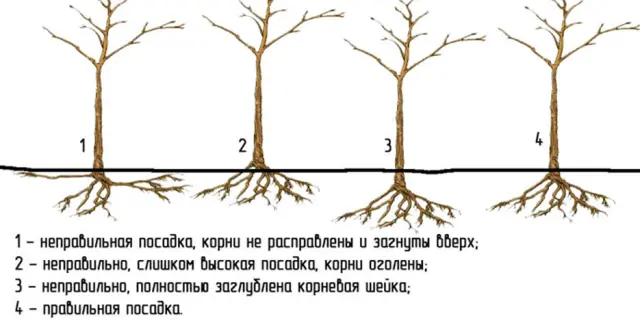
Sometimes novice gardeners take the grafting site, located 15 centimeters above the rhizome, as the root collar. If the plum is planted in the ground to such a depth, it does not bear fruit well and may die.
For proper plum planting, you need to know: the root neck is the place where the trunk ends and the root begins. It is easy to spot by its color. Wipe the bole and the upper part of the rhizome with a damp cloth. The transition from green to brown will be the root collar. It is contraindicated to deepen the neck. What happens in this case:
- from the contact of the soil with the trunk, the latter becomes damp;
- the plant begins to rot gradually, it becomes lethargic and it seems that the seedling lacks moisture; after watering, the situation is even more aggravated;
- the bark dies, metabolic processes are disturbed;
- the plum is dying.
The nuances of planting plums in the fall
Plum planting in autumn is carried out no earlier than September 15 and no later than the end of September. If the autumn is very warm and frost is not expected in the next month, the planting period can be extended until mid-October. The choice of planting material in the season is large and you can save on the purchase. Planting is carried out according to the spring scheme, but fertilizers are not added to the ground.
Planting a plum with a closed root system in spring
Open root seedlings (OCS) are placed in a thick film together with the rest of the earth, moistened and put up for sale. They are planted in autumn or dug in until spring.
Seedlings with a closed root system (ZKS) are sold in containers with earth (artificial soil). They are more expensive, but have their advantages.
- If a seedling with ACS is not intended for storage at all, then it can be stored with the ground for a long time. A fairly adult plum is already purchased.
- Trees with ACS are planted only at certain times, and plums with ACS will take root perfectly at any time of the year (except for hot summer days).
- When planting in open ground, the root system does not suffer.
- Since the ZKS is well developed, the timing of flowering and fruiting comes earlier.
- The seedling with ZKS is convenient for transportation.
Landing is simple:
- They dig a hole a little larger than the earthen coma in which the plant is placed. Make drainage.
- Gently place the rhizome with earth in the pit.
- Fill voids with earth mixed with fertilizer (superphosphate, ash).
- Water well for several days. Mulch.
Do I need to prune a plum seedling when planting
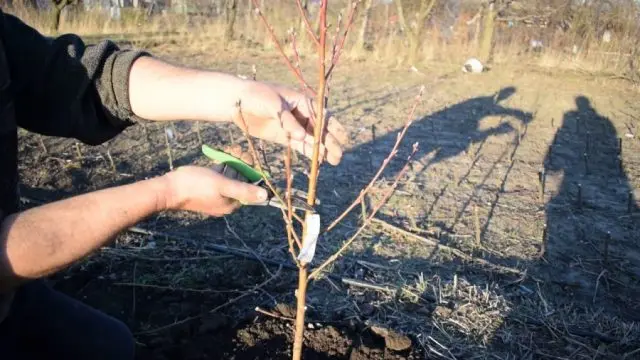
When digging up a young plum in the nursery, the roots are injured and chopped off. The communication of the power supply systems of the root and the ground part is disrupted. To establish a normal ratio of plant parts after planting, branches are pruned. Moreover, the more roots are cut off, the more intensively the crown is cut off. It can be reduced by a third or even by half. Lateral branches from above are cut off stronger than the lower ones, weak ones are not cut off at all. Without proper care, the plum will not bear fruit abundantly.
How to feed a plum after planting
Plum care must be carried out correctly and systematically.
At the time of planting, the first top dressing is carried out. Humus is introduced into the planting pit – 5 kg; peat in the same amount, superphosphate, ash.
It alkalizes the soil, especially acidic, it favorably affects cultivation.
In the second year, the plum is fed with carbamide (urea).
Young plums are fed 2 times a season – in mid-May and June. Any type of top dressing is used: granules are scattered (20 g of carbamide per 1 sq. M.) Or foliar top dressing is used. The solution is prepared in accordance with the instructions.
In the third year, the plum is fed: in early May – with urea (30 g of urea per bucket of water), in early June – nitrophoska (4 tablespoons of the substance per bucket of water), in early August they are fed again with a mixture of potassium salt and superphosphate (2 tbsp. l per 10 liters of water) 3 buckets of nutrient composition are poured under the drain.
With minerals, it is effective to use organic matter for growing and caring. In the third year after planting, a solution of mullein is added. It is insisted for 10 days, diluted with water (0,5 l of infusion per bucket of water) and poured under the drain.
Watering plum seedlings after planting
During the summer, plum care includes mandatory watering once a week. Under one plum pour 1 liters of water. In order not to erode the humus, irrigation is used for two hours.
If the summer is very hot and dry, the plum is watered more often, if it is rainy – less often. In the second year of plum cultivation, irrigation and watering is carried out according to need and weather conditions.
A useful option for summer plum care is sprinkling. Young trees bathe in the summer heat and autumn warm weather. Spraying in the summer is carried out only in the evening. Sprinkling seedlings hardens them and prepares them for temperature changes. The shower starts in the evening and ends in the early morning. The trunk circle after watering is mulched with sawdust, needles, peat.
How to transplant a plum
Often, due to redevelopment of the garden or an unsuccessful choice of planting site, the plum tree needs to be transplanted. This must be done with minimal trauma to the plum. It is best to transplant the plant up to 4 years (good survival). For the autumn transplant, the pit is prepared 20 days before, for the spring – in the fall. Drainage is poured at the bottom of the pit (expanded clay, broken brick), then sprinkled with compost and earth on top.
When is the best time to transplant a plum: in spring or autumn
You can transplant the culture both in spring and autumn, the main thing is that the plum has time to take root before the onset of cold weather or heat. In early spring, the growing conditions change in April, until the juices go, but the earth has already warmed up. Later transplantation is carried out from the end of September to October 20. Winter-hardy plum species can be replanted as soon as the snow melts.
How to transplant a plum in the spring to a new place

The best time for a plum transplant is the beginning of spring, until the buds start to grow, before the sap flow.
- First, a place is selected where the plum will be grown. It should be sunny, protected from the wind.
- If the plum is supposed to be carried far, the roots are wrapped in a dense film or matting. An adult plum is placed in a box knocked together from boards.
- After transportation, the underground part of the plum is evaluated. Everything that is rotten, dried up and broken off is removed, the places of cuts are treated with ash.
- If the rhizome has dried up, it is briefly placed in water.
- The root neck does not deepen during transplantation.
- The pit is covered with garden soil and watered, then mulched.
Plum transplant in autumn to a new place
October is the most suitable month for autumn plum transplantation. The air temperature at this time is already low, but the ground has not yet frozen, which means that the plant has the opportunity to put young shoots into warm soil. Care includes mulching the trunk circle to protect the young root from the cold.
How to transplant a young plum tree in spring
Before transplanting, within a radius of 30–40 cm from the trunk, the top layer of soil is removed and the resulting groove is filled with water to allow the earthy coma with roots to become sour. You can even shake a young plum a little. After softening the soil, if necessary, put a log under the root – a kind of lever – and pull out the plum. After transplanting, the earth is not trampled down, just watered. The tree is tied up, the soil is mulched.
How to transplant an adult plum
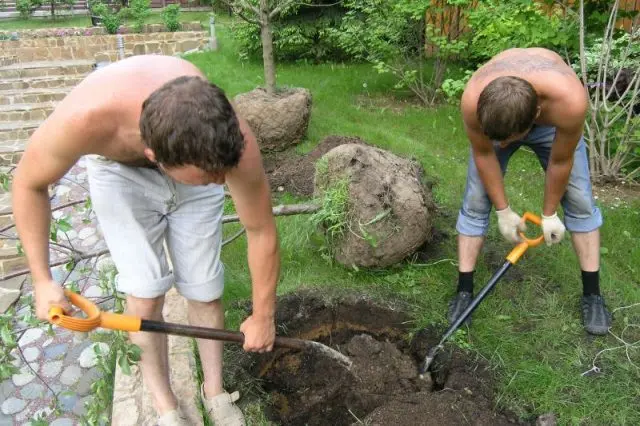
A fruiting plum, which is more than 7 years old, is transplanted together with an earthen clod 70 cm high and 1 m in diameter. Plant it in a prepared hole at the same planting depth. Spill well with water, and when the soil settles a little, add more earth.
An adult plum is fixed on both sides with ropes for stability. After that, the space remaining around the plum is filled with a nutrient mixture: 50% rotted manure, 20% sand and 30% top layer. The grooves are rammed and filled with water. The bases of the branches are tied with burlap and moistened with water for a month.
You can transplant a plum without an earthy coma. They put a tree in a dug hole, pour earth mixed with humus on it (carefully so as not to bend the roots), water it thoroughly and put spacers so that it does not fall. Subsequent care – mulching with a layer of 10 cm.
How to dig a plum for transplanting
First of all, it is determined what size the earthen lump dug with the tree will be. If the plum is more than 5 years old, then the diameter will be approximately 1 m, if more than 10 – 1,5 m.
Further actions are as follows:
- So that the lump does not crumble, the soil around the drain is well shed with water (50 l).
- Ringed with a ditch 70 cm deep.
- With an ax, they cut off the roots that go beyond the boundaries of the circle. You can use a hacksaw. The ends of the roots are cleaned with a knife and treated with var.
- The plum is carefully pulled out of the ground, holding the base of the trunk.
- An earthen ball with a plum is packed in burlap or a large box and taken to a new landing site.
If the plum roots are large, dig until the tree is completely free from the ground. Then put a log across the pit and try to pull the trunk out with a lever. Don’t push too hard, be careful. Try not to shower the earth from the roots.
Is it possible to transplant plum blossoms in May
This landing is allowed only when necessary. You can transplant, but you should not count on fruits in the coming season. And if the roots are damaged, then in the next two years, too.
Cultivation and care of plum
In order for the plum to please the crops, you need before growing:
- not only choose the right varieties, but also choose the types of pollinators;
- determine the correct landing site, timing, choose a good seedling;
- observe all the necessary techniques and agricultural practices for plum care.
Top dressing plums
The development of plums during cultivation is stimulated by top dressing. For the first 2-3 years after planting, the plum will have enough substances introduced during the laying. Then the fertilizers alternate: for a year, the plum is fed with organic matter (infusions of mullein, bird droppings, slurry, compost, herbal “brilliant green”), for a year – with mineral salts (in April, before flowering, – 15–20 g of urea per 1 m², in May, after flowering – 20 g of double superphosphate + 30 g of potassium sulfate per 1 m² of the trunk circle). Of the inorganics, the plum needs phosphorus and potassium (for the development of the root and the formation of beautiful fruits).
How to water a plum
In spring, there is enough moisture in the soil, and the drain does not need watering. She needs it during the period of fruit ripening, from June to August inclusive. Irrigation rate – 50 liters per 1 m². The wet care schedule is something like this:
- immediately after landing;
- during the formation of the ovary and the growth of shoots;
- a week before fruit picking;
- after harvest (if the summer is very dry);
- in October (if the autumn is warm and there is a need for this).
In this case, it is necessary to observe some rules of wet care:
- Plums are not watered just before fruit ripening. Too much moisture will crack the skin.
- Do not allow the soil to dry out, it is dangerous for the plum. Both ovaries and leaves will fall, as a result, the plum may die.
- The best care in hot weather is watering under the root.
Trimming Prunes
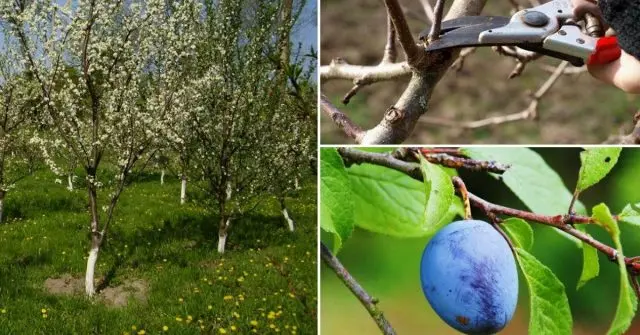
Trimming care is carried out in March, in early spring. Trees are formed in tiers (3-3-2 skeletal branches). Distance between branches – 15 cm, between tiers – 50 cm. Stem height – 40 cm.
Developed branches of young plums more than 45 cm long are shortened by 1/4 of the length to stimulate the formation of shoots. During fruiting, the crown is relieved of dry and thickening branches.
- If the growth is weak (10–15 cm), then a rejuvenating pruning is carried out on a 5-year-old lateral branch.
- Annually, in early spring and autumn, plum shoots are removed, cutting it to the base of the root system.
Mulching
Mulching when growing plums is carried out to maintain the qualitative composition of the soil. It prevents the formation of an earthen crust and does not allow moisture to evaporate quickly.
Mulch for plum care is organic (sawdust, shavings, mowed grass, hay, needles, moss) and inorganic (newspapers and films). Its functions are as follows:
- insulates the entire underground part of the plant;
- reflects the sun’s rays;
- prevents the soil from drying out, retaining moisture;
- does not allow weeds to grow.
Plum when grown forms more adventitious roots if mulched. Before this type of care, top dressing is carried out.
Mistakes beginner gardeners make
Even experienced gardeners make mistakes when planting and growing a plum tree, to say nothing of beginners. There are a number of common mistakes that are sometimes impossible to fix, but can be prevented by knowing about them in advance. These errors are worth paying attention to.
- It is imprudent to buy trees for planting in the market from cars. Do not be tempted by the cheapness of the goods, quality goods are offered only in nurseries.
- The optimal planting time for plums is from September 15 to 25. Do not succumb to the general hype and buy planting material at the end of August. It is useless to plant such a plant in a permanent place. You can save him only in a dig under a snow shelter or in a cold basement.
- Fertilize the plum exactly according to the instructions. She will not withstand mineral aggression when leaving.
- Do not put fresh manure or a highly concentrated infusion of chicken manure into the pit when planting plums. Organics with such a low degree of decomposition, falling into the soil, release ammonia and a lot of heat. This oppresses the trunk and burns the roots, making it difficult to grow.
- Do not water the plum often, but little by little. Such watering care forms an earthen crust and dries out the soil.
- Do not put a thick layer of mulch immediately after planting, otherwise the bark will prop up.
Conclusion
Plum planting is not an easy process, promising results after 3 years of caring for it. If grown and cared for correctly, a plum that lives an average of 30 years, 25 of them will delight in a rich and increasing yield from year to year.










